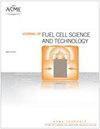Investigation of Mechanical Behavior of Membrane in Polymer Electrolyte Fuel Cells Subject to Dynamic Load Changes
引用次数: 8
Abstract
One of the major barriers for polymer electrolyte membrane (PEM) fuel cells to be commercially viable for stationary and transportation applications is the durability of membranes undergoing chemical and mechanical degradation over the period of operation. Toward understanding the effects of operating parameters on membrane durability, this paper presents numerical simulations for a single channel PEM fuel cell undergoing changes in load, by subjecting a unit cell to step changes in voltage. The objective is to elucidate the mechanical response of the membrane, which is subjected to hygral (water) loading and unloading cycles at constant temperature. Detailed three-dimensional (3D) computational fluid dynamics (CFD) simulations are conducted, taking into account the complex interactions of water transport dynamics and load changes, to accurately capture the water content in the membrane with changes in cell voltage. The water content obtained through CFD simulations is, in turn, used to carry out two-dimensional (2D) finite element (FE) analysis to predict the mechanical response of the membrane undergoing cyclic change in water content, as the operating voltage is cycled. The effects of cyclic changes in cell potential on the stresses induced, amount of plastic strain, and its localization are analyzed for various inlet cathode humidity values for two sections along the length of the fuel cell.动态载荷变化下聚合物电解质燃料电池膜的力学行为研究
聚合物电解质膜(PEM)燃料电池在固定式和运输中商业化应用的主要障碍之一是膜在运行期间经历化学和机械降解的耐久性。为了了解操作参数对膜耐久性的影响,本文通过对单元电池施加电压阶跃变化,对负载变化的单通道PEM燃料电池进行了数值模拟。目的是阐明膜的力学响应,这是受到在恒定温度下的hyhyal(水)加载和卸载循环。通过详细的三维(3D)计算流体动力学(CFD)模拟,考虑了水传输动力学和负载变化的复杂相互作用,以准确捕获随电池电压变化的膜内含水量。通过CFD模拟得到的含水率,再用于进行二维有限元分析,预测在工作电压循环作用下,膜在含水率发生循环变化时的力学响应。分析了沿燃料电池长度方向两段不同入口阴极湿度值下电池电位循环变化对诱导应力、塑性应变量及其局部化的影响。
本文章由计算机程序翻译,如有差异,请以英文原文为准。
求助全文
约1分钟内获得全文
求助全文
来源期刊
自引率
0.00%
发文量
0
审稿时长
6-12 weeks
期刊介绍:
The Journal of Fuel Cell Science and Technology publishes peer-reviewed archival scholarly articles, Research Papers, Technical Briefs, and feature articles on all aspects of the science, engineering, and manufacturing of fuel cells of all types. Specific areas of importance include, but are not limited to: development of constituent materials, joining, bonding, connecting, interface/interphase regions, and seals, cell design, processing and manufacturing, multi-scale modeling, combined and coupled behavior, aging, durability and damage tolerance, reliability, availability, stack design, processing and manufacturing, system design and manufacturing, power electronics, optimization and control, fuel cell applications, and fuels and infrastructure.

 求助内容:
求助内容: 应助结果提醒方式:
应助结果提醒方式:


